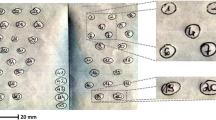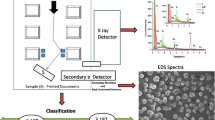Abstract
The authenticity of objects and artifacts is often the focus of forensic analytic chemistry. In document fraud cases, the most important objective is to determine the origin of a particular ink. Here, we introduce a new approach which utilizes the combination of two analytical methods, namely Raman spectroscopy and laser-induced breakdown spectroscopy (LIBS). The methods provide complementary information on both molecular and elemental composition of samples. The potential of this hyphenation of spectroscopic methods is demonstrated for ten blue and black ink samples on white paper. LIBS and Raman spectra from different inks were fused into a single data matrix, and the number of different groups of inks was determined through multivariate analysis, i.e., principal component analysis, soft independent modelling of class analogy, partial least-squares discriminant analysis, and support vector machine. In all cases, the results obtained with the combined LIBS and Raman spectra were found to be superior to those obtained with the individual Raman or LIBS data sets.

Combination of Raman spectroscopy and LIBS for improved classification of inks: score plot from PCA and experimental set-up




Similar content being viewed by others
References
Bitossi G, Giorgi R, Mauro M, Salvadori B, Dei L (2005) Spectroscopic techniques in cultural heritage conservation: a survey. Appl Spectrosc Rev 40:187–228
Clark RJH (2002) Pigment identification by spectroscopic means: an arts/science interface. CR Chim 5:7–20
Vogt C, Vogt J, Becker A, Rohde E (1997) Separation, comparison and identification of fountain pen inks by capillary electrophoresis with UV-visible and fluorescence detection and by proton-induced X-ray emission. J Chromatogr A 781:391–405
Thanasoulias NC, Parisis NA, Evmiridis NP (2003) Multivariate chemometrics for the forensic discrimination of blue ball-point pen inks based on their Vis spectra. Forensic Sci Int 138:75–84
Zlotnick JA, Smith FP (1999) Chromatographic and electrophoretic approaches in ink analysis. J Chromatogr B 733:265–272
Ezcurra M, Góngora JMG, Maguregui I, Alonso R (2010) Analytical methods for dating modern writing instrument inks on paper. Forensic Sci Int 197:1–20
Brackett JW, Bradford LW (1952) Comparison of ink writing on documents by means of paper chromatography. J Crim Law Criminol Police Sci 43:530–539
Brown C, Kirk PL (1954) Horizontal paper chromatography in the identification of ball point inks. J Crim Law Criminol Police Sci 45:334–339
Yao YT, Song J, Yu J, Wang XF, Hou F, Zhang AL, Liu Y, Han J, Xie MX (2009) Differentiation and dating of red ink entries of seals on documents by HPLC and GC/MS. J Sep Sci 32:2919–2927
Claybourn M, Ansell M (2000) Using Raman Spectroscopy to solve crime: inks, questioned documents and fraud. Sci Justice 40:261–271
Mazzella WD, Buzzini P (2005) Raman spectroscopy of blue gel pen inks. Forensic Sci Int 152:241–247
Poon KWC, Dadour IR, McKinley AJ (2008) In situ chemical analysis of modern organic tattooing inks and pigments by micro-Raman spectroscopy. J Raman Spectrosc 39:1227–1237
Zięba-Palus J, Kunicki M (2006) Application of the micro-FTIR spectroscopy, Raman spectroscopy and XRF method examination of inks. Forensic Sci Int 158:164–172
Melessanaki K, Papadakis V, Balas C, Anglos D (2001) Laser induced breakdown spectroscopy and hyper-spectral imaging analysis of pigments on an illuminated manuscript. Spectrochim Acta B 56:2337–2346
Oujja M, Vila A, Rebollar E, Garcia JF, Castillejo M (2005) Identification of inks and structural characterization of contemporary artistic prints by laser-induced breakdown spectroscopy. Spectrochim Acta B 60:1140–1148
McCreery RL (2000) Raman spectroscopy for chemical analysis. Wiley, New York
Osticioli I, Mendes NFC, Porcinai S, Cagnini A, Castellucci E (2009) Spectroscopic analysis of works of art using a single LIBS and pulsed Raman setup. Anal Bioanal Chem 394:1033–1041
Hoehse M, Gornushkin I, Merk S, Panne U (2011) Assessment of suitability of diode pumped solid state lasers for laser induced breakdown and Raman spectroscopy. J Anal Atom Spectrom 26:414–424
Marquardt BJ, Cremers DA, Angel SM (1998) Novel probe for laser-induced breakdown spectroscopy and Raman measurements using an imaging optical fiber. Appl Spectrosc 52:1148–1153
Zięba-Palus J, Borusiewicz R, Kunicki M (2008) Praxis-combined [μ]-Raman and [mu]-XRF spectrometers in the examination of forensic samples. Forensic Sci Int 175:1–10
Trafela T, Strlič M, Kolar J, Lichtblau DA, Anders M, Pucko Mencigar D, Pihlar B (2007) Nondestructive analysis and dating of historical paper based on IR Spectroscopy and chemometric data evaluation. Anal Chem 79:6319–6323
Adam CD, Sherratt SL, Zholobenko VL (2008) Classification and individualisation of black ballpoint pen inks using principal component analysis of UV-vis absorption spectra. Forensic Sci Int 174:16–25
Gambaro A, Ganzerla R, Fantin M, Cappelletto E, Piazza R, Cairns W (2009) Chemical and statistical characterization of selected documents from the archives of the Palazzo Ducale (Venice, Italy). Anal Chim Acta 651:139–148
Denman JA, Skinner WM, Kirkbride KP, Kempson IM (2010) Organic and inorganic discrimination of ballpoint pen inks by ToF-SIMS and multivariate statistics. Appl Surf Sci 256:2155–2163
Kessler W (2007) Multivariate Regressionsmethoden. In: Kessler W (ed) Multivariate Datenanalyse für die Pharma-, Bio- und Prozessanalytik. Wiley-VCH Verlag GmbH & Co. KGaA, Weinheim
Izenman AJ (2008) Modern multivariate statistical techniques: regression, classification, and manifold learning. Springer, New York
Hoehse M, Mory D, Florek S, Weritz F, Gornushkin I, Panne U (2009) A combined laser-induced breakdown and Raman spectroscopy Echelle system for elemental and molecular microanalysis. Spectrochim Acta B 64:1219–1227
Schrader B, Hoffmann A, Simon A, Sawatzki J (1991) Can a Raman renaissance be expected via the near-infrared Fourier transform technique? Vib Spectrosc 1:239–250
Angeloni L, Smulevich G, Marzocchi MP (1979) Resonance Raman-spectrum of crystal violet. J Raman Spectrosc 8:305–310
Balabin MB, Lomakina EI (2011) Support vector machine regression (SVR/LS-SVM)-an alternative to neural networks (ANN) for analytical chemistry? Comparison of nonlinear methods on near infrared (NIR) spectroscopy data. Analyst 136:1703–1712
Balabin MB, Safieva RZ, Lomakina EI (2011) Near-infrared (NIR) spectroscopy for motor oil classification: From discriminant analysis to support vector machines. Microchem J 98:121–128
Acknowledgments
We gratefully acknowledge funding of this research by the Bundesministerium für Wirtschaft und Technologie BMWi MNPQ grant 21/06 and the financial support from Deutsche Forschungsgemeinschaft DFG-NSF grant GO 1848/1-1 and NI 185/38-1 (USA; Germany). The authors sincerely thank Dr. Ursula Hendriks and Dr. Gerlinda Thulke from Landeskriminalamt LKA Berlin for providing the test samples and helpful discussions. Finally, A.P. would like to acknowledge and thank Prof. W. Kessler and Dr. F. Westad for all the fruitful conversations.
Author information
Authors and Affiliations
Corresponding author
Additional information
Published in the special issue Analytical Techniques in Art, Archaeology and Conservation Science with guest editor Oliver Hahn.
Electronic supplementary material
Below is the link to the electronic supplementary material.
ESM 1
(PDF 545 kb)
Rights and permissions
About this article
Cite this article
Hoehse, M., Paul, A., Gornushkin, I. et al. Multivariate classification of pigments and inks using combined Raman spectroscopy and LIBS. Anal Bioanal Chem 402, 1443–1450 (2012). https://doi.org/10.1007/s00216-011-5287-6
Received:
Revised:
Accepted:
Published:
Issue Date:
DOI: https://doi.org/10.1007/s00216-011-5287-6




